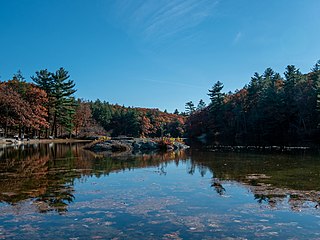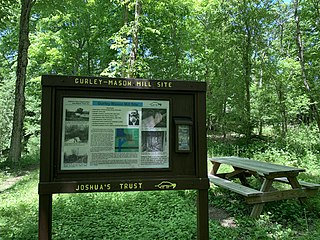
Ledyard is a Town in New London County, Connecticut, United States, located along the Thames River. The town is named after Colonel William Ledyard, a Revolutionary War officer who was killed at the Battle of Groton Heights. The town is part of the Southeastern Connecticut Planning Region. The population was 15,413 at the 2020 census. The Foxwoods Resort Casino, owned and operated by the Mashantucket Pequot Tribe, is located in the northeastern section of Ledyard, on the reservation owned by the tribe.

Historic Mill Creek Discovery Park, formerly known as Historic Mill Creek State Park is a state park, nature preserve, and historic site in the United States state of Michigan. It is run by Mackinac State Historic Parks, the operating arm of the Mackinac Island State Park. 625 acres (2.5 km2) in size, the park is located 5 miles (8 km) southeast of Mackinaw City, Michigan on U.S. Highway 23.

Breakheart Reservation is a public recreation area covering 652 acres (264 ha) in the towns of Saugus and Wakefield, Massachusetts. The reservation features a hardwood forest, two freshwater lakes, a winding stretch of the Saugus River, and scenic views of Boston and rural New England from rocky hilltops. The park is managed by the Massachusetts Department of Conservation and Recreation.

The Russell Company Upper Mill is an historic structure in Middletown, Connecticut, at the junction of Russell Street and East Main Street in South Farms, at the end of East Main Street's commercial and industrial development areas. Built in 1836, it is listed on the National Register of Historic Places. There is a small pond to the south. Small businesses border the street to the north, followed by the buildings of Russell Manufacturing Company, the area's most dominant feature. Russell Street crosses Sumner Brook nearby and ascends to a large residential district to the west. The mill is currently a condo-apartment complex.

The Elliottville Lower Mill, also known historically as the Peep Toad Mill, is an historic cotton mill in the East Killingly section of Killingly, Connecticut. Built about 1850, it is a well-preserved example of an early wood-frame textile mill. The mill complex, which includes, a dam, pond, head race, and bridge, was listed on the National Register of Historic Places in 1982.

The Talcottville Historic District is a historic district in the town of Vernon, Connecticut. Centered on Elm Hill Road and Main Street, it encompasses a 19th-century mill village, including archaeological remnants of very early cotton-spinning facilities, and old stone dam, and a major wood-frame mill constructed by the Talcott brothers. Also included in the village are a significant number of mill worker housing units, many dating to the middle decades of the 19th century, and an 1891 lenticular pony truss bridge, built by the Berlin Iron Bridge Company. The district was listed on the National Register of Historic Places in 1989.

The Richmond Furnace Historical and Archeological District is a historic industrial area located on State, Cone Hill, and Furnace Roads in Richmond, Massachusetts. The industrial history of the site dates to 1763 when the first grist and sawmills were built. In 1829, the first stone furnace was constructed for the production of iron from abundant hematite ore found nearby. It was rebuilt in 1863, and overhauled in 1905 to increase capacity. The area saw industrial iron production until 1923. The historic district also includes several other houses and buildings related to the iron works. It was added to the National Register of Historic Places in 1999.

Ascutney Mill Dam, also known as the Windsor Upper Dam and the Mill Pond Dam, is an arch-gravity dam which is one of the oldest and among the earliest storage dams in the United States. It is made of cut granite and is located in Windsor, Vermont in Windsor County near the Connecticut River, where it functioned as a source of hydropower and, later, hydroelectric power. It is on the ASCE list of historic civil engineering landmarks since 1970 and is listed on the National Register of Historic Places since January 09, 2007.

Sloat's Dam and Mill Pond is located between Waldron Terrace and Ballard Avenue in Sloatsburg, New York, United States. The 200-foot–long concrete dam creates the mill pond north of it by impounding the Ramapo River.

Hallville Mill Historic District is a historic district in the town of Preston, Connecticut, that was listed on the National Register of Historic Places in 1996. Contributing properties in the district are 23 buildings, two other contributing structures, and one other contributing site over a 50-acre (20 ha) area. The district includes the dam that forms Hallville Pond, historic manufacturing buildings and worker housing, and the Hallville Mill Bridge, a lenticular pony truss bridge built circa 1890 by the Berlin Iron Bridge Company.

The Garland Mill is a historic sawmill on Garland Road in Lancaster, New Hampshire. Built about 1860, and repeatedly modified to adapt to growth and new technology, it is the only water-powered sawmill in the state. The property was listed on the National Register of Historic Places in 1982.

The Avery Homestead is a two-story Colonial-style home in Ledyard, Connecticut that was built circa 1696. Evidence suggests that the house may have begun as a single-story, one-room house and later expanded to a two-story, two-room house by 1726. The house underwent major additions and renovations by Theophilus Avery and later his grandson, Theophilus Avery. In the mid-1950s, Amos Avery began a decade-long restoration effort to return the house to its 18th-century appearance. The Avery Homestead is historically significant as a well-preserved example of an 18th-century farmhouse with fine craftsmanship. The home is also historically important because more than twelve generations of the Avery family have resided there over the course of three centuries. The Avery Homestead was listed on the National Register of Historic Places in 1992.

Messerschmidt Pond Wildlife Management Area is a tract of land in Westbrook and Deep River, Connecticut, adjacent to Cockaponset State Forest. The area includes the millpond and former site of the Deep River Manufacturing Company, which preserved a variety of historic manufacturing machinery until its demolition in 1987. The mill and an associated shed and dam were listed on the National Register of Historic Places in 1985.

A log pond is a small natural lake or reservoir used for storage of wooden logs in readiness for milling at a sawmill. Although some mill ponds served this purpose for water-powered sawmills, steam-powered sawmills used log ponds for transportation of logs near the mill; and did not require the elevation drop of watermill reservoirs.

Hopeville Pond State Park is a public recreation area located on Hopeville Pond, an impoundment of the Pachaug River, in the town of Griswold, Connecticut. A portion of the 554-acre (224 ha) state park occupies the site of the lost village of Hopeville. The park manager's house occupies Avery House, which is listed on the National Register of Historic Places. The park offers fishing, swimming, camping, and trails for hiking and biking. It is managed by the Connecticut Department of Energy and Environmental Protection.

The Grist Mill Bridge, Dam and Mill Site consists of three structures located along Upton Road between Island Road and the Maple River, one-half mile west of Elsie, Michigan in Duplain Township. The three structures are:

The Thresher Mill is a historic industrial facility on West Barnet Road in Barnet, Vermont. First developed in 1836, it was the last water-powered mill to operate on the Stevens River, lasting into the late 20th century. The property, which includes an original mill dam and a surviving 1872 mill building, as well as archaeological sites of other industrial buildings, was listed on the National Register of Historic Places in 1996. It is now styled Ben's Mill, and is a local museum.

The Missouri Lumber and Mining Company (MLM) was a large timber corporation with headquarters and primary operations in southeast Missouri. The company was formed by Pennsylvania lumbermen who were eager to exploit the untapped timber resources of the Missouri Ozarks to supply lumber, primarily used in construction, to meet the demand of U.S. westward expansion. Its primary operations were centered in Grandin, a company town it built starting c. 1888. The lumber mill there grew to be the largest in the country at the turn of the century and Grandin's population peaked around 2,500 to 3,000. As the timber resources were exhausted, the company had to abandon Grandin around 1910. It continued timber harvesting in other parts of Missouri for another decade. While some of the buildings in Grandin were relocated, many of the remaining buildings were listed on the National Register of Historic Places in 1980 as part of the state's historic preservation plan which considered the MLM a significant technological and economic contributor to Missouri.

The Gurley-Mason Mill was a historic sawmill and gristmill located along the Fenton River on the north side of Old Turnpike Road in Mansfield, Connecticut. The mill was built around 1778, shut down around 1935, and demolished in the mid-1960s. The 2.31-acre site and ruins have been conserved by Joshua's Tract Conservation and Historic Trust since 2000. The Gurleyville Historic District lies two miles downriver.

The Wooster Sawmill and Gristmill Site is a historic industrial site on Park Road in Oxford, Connecticut. From at least 1747 until 1965 it was operated as a sawmill, gristmill, and cider mill, giving it one of the longest known histories as a water-powered mill complex in the United States. The surviving elements of the complex, its structures now converted to private residential use, were listed on the National Register of Historic Places in 2001.






















